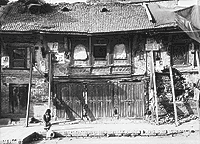 They have called Patan the Florence of the East. Bhaktapur has been compared to Seville. While the tall temples and the elegant Darbar Squares of these towns stand out, what gives them their unique urban ambience is the architecture of the individual buildings, the sidewalk temples, the rest houses and the harmony of space and colour.
They have called Patan the Florence of the East. Bhaktapur has been compared to Seville. While the tall temples and the elegant Darbar Squares of these towns stand out, what gives them their unique urban ambience is the architecture of the individual buildings, the sidewalk temples, the rest houses and the harmony of space and colour.
Heritage conservation efforts in Kathmandu Valley 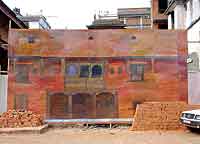 over the past 30 years have focussed on trying to restore the monuments, but the march of modernisation has eroded the character of Kathmandu Valley towns, as concrete blocks replace old-world architecture. Many invaluable, but less highlighted, monuments built by our ancestors within the depths of the dark alleys and bahals are crumbling away.
over the past 30 years have focussed on trying to restore the monuments, but the march of modernisation has eroded the character of Kathmandu Valley towns, as concrete blocks replace old-world architecture. Many invaluable, but less highlighted, monuments built by our ancestors within the depths of the dark alleys and bahals are crumbling away.
Thankfully, city planners and archaeologists and architects are now taking notice. The Kathmandu Valley Preservation Trust (KVPT) is now working to renovate the pati, pauwa, matha and mandir of the inner city. "If it weren't for non-profit groups like the KVPT, much of the Valley's architectural heritage would already have been lost. The work it does is commendable, but it has received far less media attention and promotion than it deserves," says Keshav Raj Jha, former Nepali ambassador to France and long-time consultant to the UNESCO World Heritage office Nepal.  The KVPT has been around for ten years, doing its work quietly, without too much fanfare. It has rescued over a dozen monuments of cultural value, mostly in Patan, but also in Kathmandu. It selects simple roadside structures such as the Mani Gufa temple that lies hidden beside the temple of Krishan Mandir in Patan Darbar Square, and restores it painstakingly to its previous beauty. It has also rebuilt entire temples that have been ravaged by time and weather, like the 18th century Kulima Narayan near Bagalamukhi. "The KVPT has set a standard for building conservation in Neoal which is unrivalled," says Peter Laws, a cultural heritage expert with UNESCO.
The KVPT has been around for ten years, doing its work quietly, without too much fanfare. It has rescued over a dozen monuments of cultural value, mostly in Patan, but also in Kathmandu. It selects simple roadside structures such as the Mani Gufa temple that lies hidden beside the temple of Krishan Mandir in Patan Darbar Square, and restores it painstakingly to its previous beauty. It has also rebuilt entire temples that have been ravaged by time and weather, like the 18th century Kulima Narayan near Bagalamukhi. "The KVPT has set a standard for building conservation in Neoal which is unrivalled," says Peter Laws, a cultural heritage expert with UNESCO. 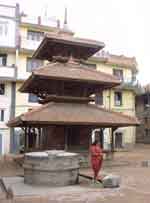 But it has not been easy for the KVPT and its director, American architect Eric G Theophile. They have had to face all sorts of problems, from fund-raising to even securing the right to restore a site. "Renovating falling structures is only one aspect of our work, we need to overcome a lot of challenges before we can even reach to that part," says KVPT's Imrana Rashid. For instance, the trust had to fight legal battles for nine years to renovate the Ayuguthi Satal in Patan. In 1992, the KVPT obtained funds to repair the crumbling satal, initially a place where the faithful sang religious hymns and pilgrims spent their nights, now long overtaken by squatters unwilling to let the Trust in. But work is now underway and renovation will be completed in March. "Once the work is done the satal will be turned into a resource and educational centre for tourists and scholars," says Rashid.
But it has not been easy for the KVPT and its director, American architect Eric G Theophile. They have had to face all sorts of problems, from fund-raising to even securing the right to restore a site. "Renovating falling structures is only one aspect of our work, we need to overcome a lot of challenges before we can even reach to that part," says KVPT's Imrana Rashid. For instance, the trust had to fight legal battles for nine years to renovate the Ayuguthi Satal in Patan. In 1992, the KVPT obtained funds to repair the crumbling satal, initially a place where the faithful sang religious hymns and pilgrims spent their nights, now long overtaken by squatters unwilling to let the Trust in. But work is now underway and renovation will be completed in March. "Once the work is done the satal will be turned into a resource and educational centre for tourists and scholars," says Rashid.
Fund-raising may be a problem, but sometimes a bigger obstacle is lack of help from the local community. Many communities have helped support the renovation by contributing labour, wood or even money. But these are exceptions. The apathy is puzzling, and is probably due to the fragmentation of clans, guthi and communities in the formerly closely-knit urban environment. Renovation of Radha Krishna temple in Patan ended in 1993, but the locals showed little enthusiasm to look after the rebuilt temple.
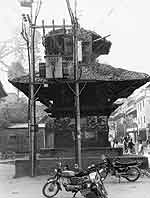 The 13th century Sulima Ratneswara is another temple in Patan that KVPT helped renovate. Manager Raju Roka partly blames the temple priests for the temples' disrepair. "There are more reasons for temples and old structures to fall apart than just old age," says Roka. He says buildings crumble because the traditional management systems designed for their upkeep have fallen apart. "The main problem with conservation here, as elsewhere," says Laws, "is of course the universal one, that of the lack of public awareness. People neglect their cultural heritage." Laws suggests that one way to ensure that building conservation is smoother is to give municipalities more power, so they can make the road easier for organisations
The 13th century Sulima Ratneswara is another temple in Patan that KVPT helped renovate. Manager Raju Roka partly blames the temple priests for the temples' disrepair. "There are more reasons for temples and old structures to fall apart than just old age," says Roka. He says buildings crumble because the traditional management systems designed for their upkeep have fallen apart. "The main problem with conservation here, as elsewhere," says Laws, "is of course the universal one, that of the lack of public awareness. People neglect their cultural heritage." Laws suggests that one way to ensure that building conservation is smoother is to give municipalities more power, so they can make the road easier for organisations 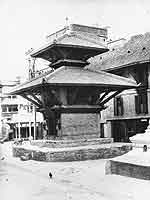 such as the KVPT.
such as the KVPT.
Where KVPT's work has been smoother is where local bodies such as guthi are intact. And the most heartening impact of the Trust's work is what some call the "demonstration effect" evident all over Patan today-when residents of an area see one building being restored, and see that there are often tangible benefits that can accrue from it, they are more receptive to doing the same. As one reaches the Kulima Narayan temple, an old building on the right, in the same style, is being renovated. Until some time ago, the owners were planning to destroy the decades-old building and have a concrete structure. With help and advice from KVPT, the owners are now turning the building into a bed and breakfast pension where tourists can enjoy living in an old-style Newari house with modern comforts.
There are positive signs that the awareness level among the local community concerning architectural heritage is also increasing. A walk around Patan reveals numerous houses being re-built in old-style architecture, even though modern materials have been used. Says KVPT board member and director of development Gautam SJB Rana: "Compared to the past, the situation has certainly improved a lot and people have begun to realise the importance of these structures." Rana was the first Nepali to be elected to the board of directors of KVPT. Rana has been a longtime supporter of the trust's work with his own Baber Mahal Revisited-an example of cultural heritage conservation.
In Kathmandu, the Trust is working to re-renovate the Jaganath Temple which had been destroyed by monsoon rains, and disturbed by shoddy reconstruction. There are also plans to renovate a falling Sherpa monastery in Junbesi in Solu Khumbu, but that has had to be shelved because of the counter-insurgency operation.
KVPT's real seriousness is reflected by its office. It is a rented old Newari house near Patan Durbar Square, re-vamped with a style and grace that symbolises its passion for conservation. With its traditional exterior and modern office space, it reflects a perfect and harmonious blend of old and new. They certainly practice what they preach.


